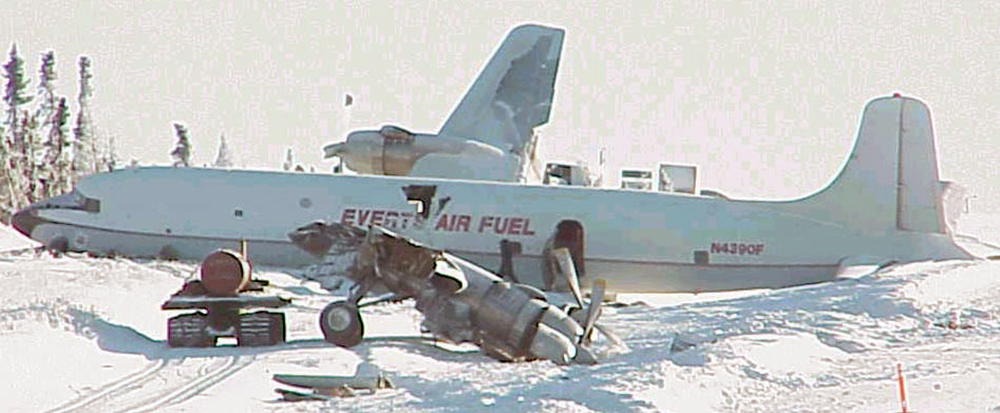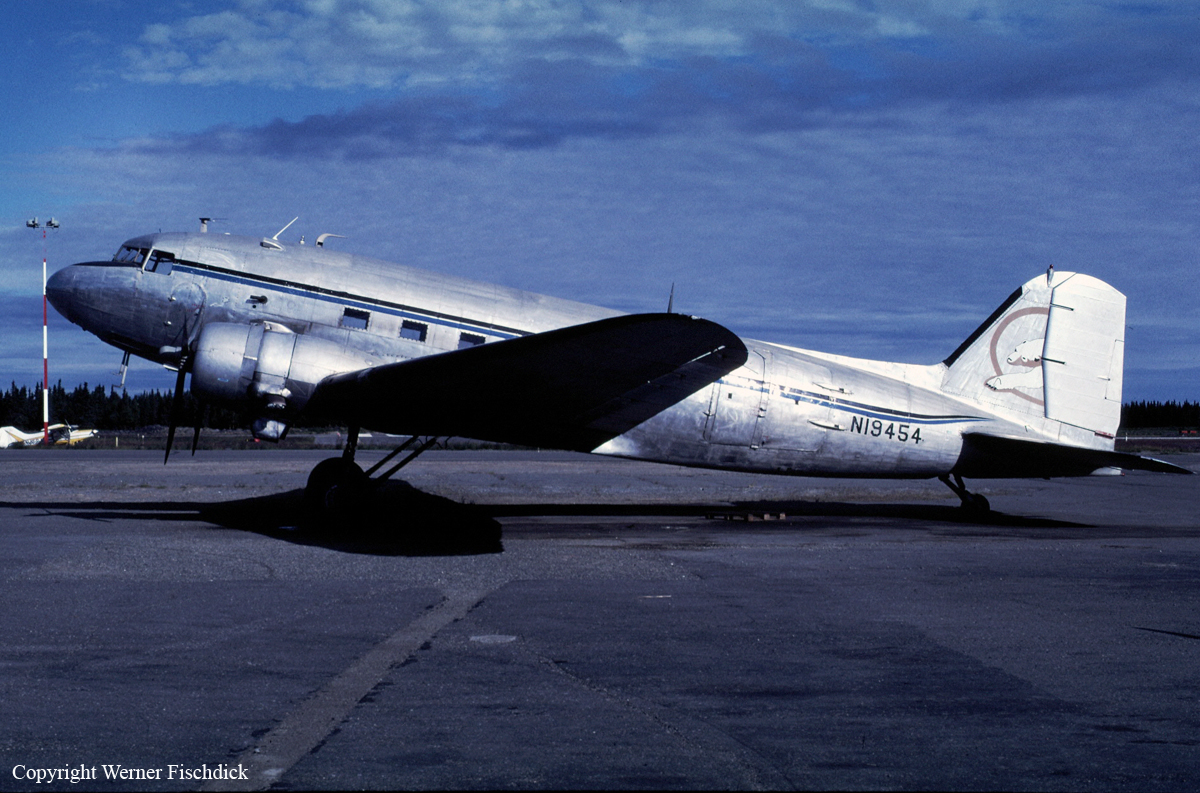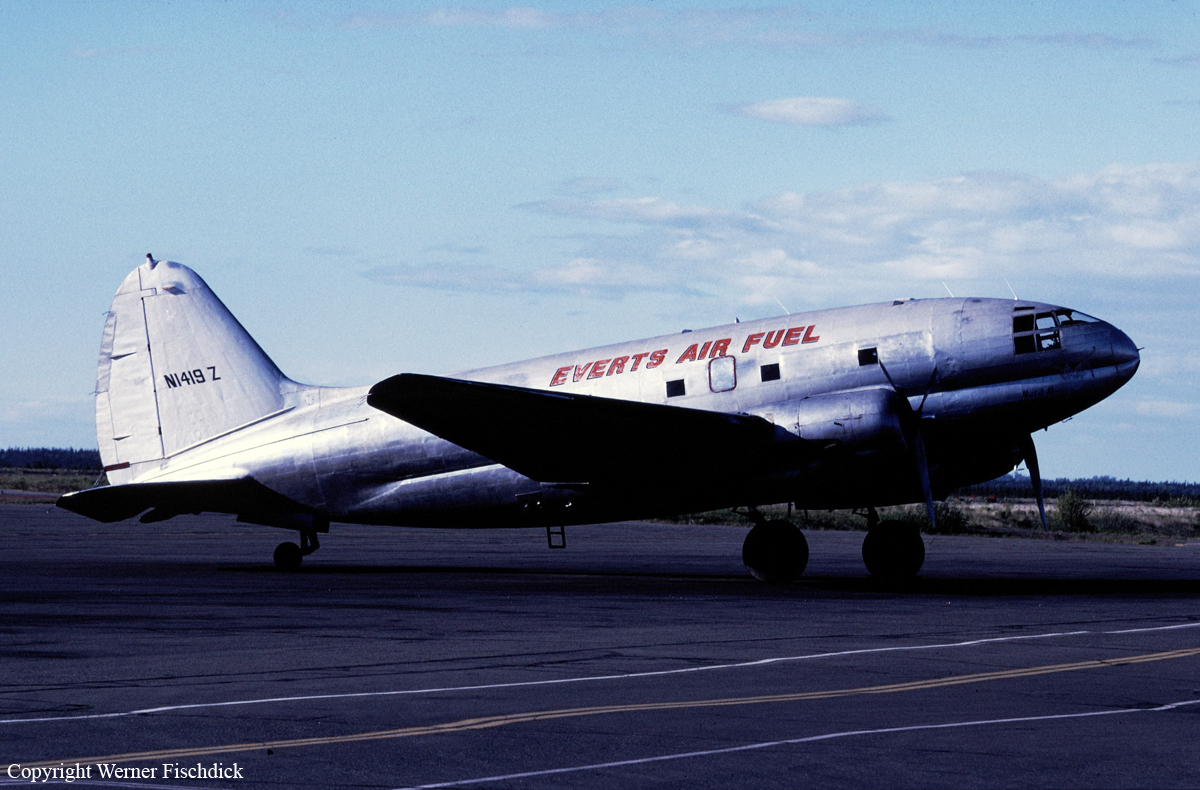Country
code
AK
Crash of a Douglas DC-6B in Donlin Creek
Date & Time:
Jan 31, 2001 at 1315 LT
Registration:
N4390F
Survivors:
Yes
Schedule:
Fairbanks – Donlin Creek
MSN:
44898
YOM:
1956
Crew on board:
3
Crew fatalities:
Pax on board:
0
Pax fatalities:
Other fatalities:
Total fatalities:
0
Captain / Total hours on type:
8100.00
Aircraft flight hours:
37052
Circumstances:
The certificated airline transport captain related that the purpose of the flight was to deliver about 4,800 gallons of fuel oil to the remote mining site. He said that the 5,400 feet long by 100 feet wide airstrip was situated within hilly, snow-covered terrain. He added that the airstrip has a 7 percent uphill grade. Flat light conditions existed at the airstrip, and light snow showers were present, with visibility reported at 2 miles. The captain stated that during final approach, as the airplane passed over the airstrip threshold, flat light conditions made it very difficult to discern where the airstrip surface was. He said that the initial touchdown was "firm", but was thought to be within acceptable tolerances. Just after touchdown, the left wing broke free from the airplane at the wing to fuselage attach point. The airplane veered to the left, and off the left side of the runway. The captain said that the airplane's computed landing weight was 92,260 pounds.
Probable cause:
The flight crew's misjudged flare while landing. Factors associated with the accident were flat light conditions, snow-covered terrain, and an uphill runway grade.
Final Report:


Crash of a Douglas DC-3C-S1C3G in Unalaska: 2 killed
Date & Time:
Jan 23, 2001 at 2135 LT
Registration:
N19454
Survivors:
No
Schedule:
Unalaska - Anchorage
MSN:
25309
YOM:
1944
Crew on board:
2
Crew fatalities:
Pax on board:
0
Pax fatalities:
Other fatalities:
Total fatalities:
2
Aircraft flight hours:
55877
Circumstances:
A Douglas DC-3 airplane departed an island runway during dark night, VFR conditions without filing a flight plan. The airplane collided with a volcanic mountain at 1,500 feet msl on the runway heading, 4.5 miles from the airport. Earlier in the day, the airplane arrived from Anchorage, Alaska, without a flight plan, having flown along the Alaska Peninsula when VFR flight was not recommended. The crew of the airplane initially planned to remain overnight on the peninsula, but the captain received a request to transport cargo to Anchorage. The airplane was loaded with cargo and fuel, and departed. The crew did not file a flight plan. The end of the departure runway is positioned at the edge of an ocean bay. Beyond the end of the runway, open water and rising volcanic island terrain are present. In the area of intended flight, no illumination of the terrain, or any ground based lighting was present. An obstacle departure procedure for the departure runway recommends a right turn at 2 DME from the runway heading, and then a climb to 7,000 feet. Forty-five minutes after departure, a fire was spotted on the side of a volcano cone, and an ELT signal was detected in the area. No company flight following procedures were found for the accident flight, and the airplane was not reported overdue until the following day. The day after the accident, the airplane wreckage was located on steep, snow-covered terrain. Due to high winds and blowing snow, a rescue team could not get to the accident site until three days after the crash. The captain was the president, the director of operations, and the sole corporate entity of the company. No current maintenance records, flight logs, or pilot logs were located for the company. In the past, the captain's pilot certificate was suspended for 45 days following an accident in a DC-3 airplane when he ran out of gas. Also, the captain's medical certificate had previously been considered for denial after serving 49 months in federal prison for cocaine distribution, but after review, the FAA issued the captain a first class medical. FAA medical records for the captain do not contain any record of monitoring for substance abuse. The first officer's medical had also been considered for denial after an episode of a loss of consciousness. After a lengthy review and an appeal to the NTSB, the FAA issued the first officer a second-class medical. The first officer was part of the flight crew when the captain ran out of gas, and she had two previous aviation accidents. A toxicological examination of the captain, conducted by the FAA, found cocaine and metabolites of cocaine. A toxicological examination of the first officer found two different prescription antidepressant drugs. The FAA prohibits narcotic and mood-altering drug use by pilots.
Probable cause:
The airplane flightcrew's failure to maintain adequate distance/altitude from mountainous terrain during a departure climb to cruise flight, and the captain's impairment from drugs. Factors in the accident were dark night conditions, and the first officer's impairment from drugs.
Final Report:

Crash of a Curtiss C-46A-45-CU Commando near Mt Redoubt: 2 killed
Date & Time:
Dec 20, 2000 at 1620 LT
Registration:
N1419Z
Survivors:
No
Schedule:
Kenai – Big River Lakes – Nondalton – Kenai
MSN:
30228
YOM:
1944
Crew on board:
2
Crew fatalities:
Pax on board:
0
Pax fatalities:
Other fatalities:
Total fatalities:
2
Captain / Total hours on type:
1540.00
Aircraft flight hours:
10907
Circumstances:
The flight crew was returning from off-loading their cargo at a remote site on the west side of a mountain range. The return flight would provide an option of following a lower mountain pass, or flying over the mountainous terrain. Witnesses related that prior to the flight's departure, the marginal VFR weather conditions began to deteriorate very rapidly, with winds in excess of 50 knots, lowering ceilings, rain, and turbulence. An airmet, valid during the time of the accident, forecast high winds, mountain obscuration, and turbulence. The wreckage of the airplane was located near the crest of a 2,900 feet msl ridge. Wreckage debris was scattered on both sides of the ridge, and the airplane was destroyed by the high speed impact. Inspection of the wreckage disclosed no evidence any mechanical anomalies. A radar track analysis of a target airplane believed to be the accident airplane, depicted a track on a direct route of flight over the mountains from the departure airport towards the destination airport. Altitude data was not received from the target airplane's Mode C transponder, and therefore was extrapolated from the less reliable radar plot information. The maximum altitude plotted was approximately 10,800 feet, prior to a descent as the airplane neared the west side of the range. Mountains along the route of flight exceed 10,000 feet msl.
Probable cause:
The flight crew's decision to continue VFR flight into instrument meteorological conditions. Factors associated with the accident are high winds, turbulence, and low ceilings.
Final Report:

Crash of a Cessna 207 Skywagon in 47 Mile Creek: 1 killed
Date & Time:
Sep 20, 2000 at 0615 LT
Registration:
N42472
Survivors:
No
Schedule:
47 Mile Creek – Aniak
MSN:
207-0148
YOM:
1970
Crew on board:
1
Crew fatalities:
Pax on board:
0
Pax fatalities:
Other fatalities:
Total fatalities:
1
Captain / Total hours on type:
900.00
Circumstances:
The air taxi pilot had flown to a remote airstrip and lodge in a company airplane to go hunting. He was scheduled the next morning for a flight from his company's base of operations, his original departure airport. According to a hunting guide at the lodge, the pilot departed the lodge's airstrip about 0608, with a load of revenue cargo. A few minutes later, the guide heard the sound of an airplane, and then a loud impact. The guide could not see the wreckage because it was too dark outside. He departed in his own airplane, but entered clouds shortly after takeoff, and had to return. The guide commented he thought the accident pilot was trying to return to the lodge airstrip because of the poor weather and darkness. The wreckage was located on a nearby mountain in daylight hours after the cloud cover had dissipated. Post accident inspection disclosed no evidence of any preimpact mechanical anomalies with the airplane. Official sunrise was 0813; official civil twilight was 0730. The time of the accident was approximately 0615.
Probable cause:
The pilot's decision to initiate visual flight into dark night instrument meteorological conditions. Factors associated with the accident are a low ceiling, a dark night, the pilot's failure to follow regulatory procedures and directives, and his self-induced pressure to return to base to take another flight.
Final Report:
Crash of a Piper PA-31T3-T1040 Cheyenne in Nuiqsut: 5 killed
Date & Time:
Sep 18, 2000 at 1510 LT
Registration:
N220CS
Survivors:
Yes
Schedule:
Deadhorse – Nuiqsut
MSN:
31-8275013
YOM:
1982
Flight number:
6C181
Crew on board:
1
Crew fatalities:
Pax on board:
9
Pax fatalities:
Other fatalities:
Total fatalities:
5
Captain / Total hours on type:
165.00
Aircraft flight hours:
10157
Circumstances:
The airline transport certificated pilot was landing at a remote village on a scheduled domestic commuter flight with nine passengers. The accident airplane, a twin-engine turboprop certified for single-pilot operations, was equipped with a fuselage-mounted belly cargo pod. Witnesses saw the airplane touch down on the gravel runway with the landing gear retracted. The belly pod lightly scraped the runway for about 40 feet before the airplane transitioned to a climb. The propeller tips did not contact the runway. As the airplane began climbing away from the runway, the landing gear was extended. The airplane climbed to about 100 to 150 feet above the ground, and then began a descending left turn, colliding with tundra-covered terrain. A postcrash fire destroyed the fuselage, right wing, and the right engine. The flaps were found extended to 40 degrees. The balked landing procedure for the airplane states, in part: "power levers to maximum, flaps to 15 degrees, landing gear up, and then retract the flaps." Five passengers seated in the rear of the airplane survived the crash. The survivors did not recall hearing a gear warning horn before ground contact. The airplane was landed gear-up eight months before the accident. The airplane was nearly landed gear-up four months before the accident. Each time, a landing gear warning horn was not heard by the pilot or passengers. A postcrash examination of the airplane and engines did not locate any preimpact mechanical malfunction. The FAA's Fairbanks, Alaska, FSDO conducted an inspection of the operator six months before the accident, and recommended the operator utilize two pilots in the accident airplane. Following the accident, the Fairbanks FSDO required the operator to utilize two pilots for passenger flights in the accident airplane make and model.
Probable cause:
The pilot's failure to extend the landing gear, his improper aborted landing procedure, and inadvertent stall/mush. Factors in the accident were an improper adjustment of the landing gear warning horn system by company maintenance personnel, and the failure of the pilot to utilize the pre-landing checklist.
Final Report:
Crash of a Piper PA-31T3-T1040 Cheyenne in Kotzebue
Date & Time:
Feb 21, 2000 at 1123 LT
Registration:
N219CS
Survivors:
Yes
Schedule:
Point Lay - Kotzebue
MSN:
31-8275005
YOM:
1982
Crew on board:
1
Crew fatalities:
Pax on board:
0
Pax fatalities:
Other fatalities:
Total fatalities:
0
Captain / Total hours on type:
4900.00
Aircraft flight hours:
11098
Circumstances:
The airplane collided with frozen pack ice, three miles from the airport, during a GPS instrument approach. Instrument conditions of 3/4 mile visibility in snow and fog were reported at the time of the accident. The pilot stated that he began a steep descent with the autopilot engaged. He indicated that as the airplane crossed the final approach course, the autopilot turned the airplane inbound toward the airport. He continued the steep descent, noted the airplane had overshot the course, and the autopilot was not correcting very well. He disengaged the autopilot and manually increased the correction heading to intercept the final approach course. During the descent he completed the landing checklist, extended the landing gear and flaps, and was tuning both the communications and navigation radios. The pilot said he looked up from tuning the radios to see the sea ice coming up too quickly to react, and impacted terrain. The pilot relayed there were no pre accident anomalies with the airplane, and that he 'did not stay ahead of the airplane.'
Probable cause:
The pilot descended below the minimum descent altitude. Factors associated with this accident were the task overload of the pilot during the instrument approach, and not performing a level off.
Final Report:



